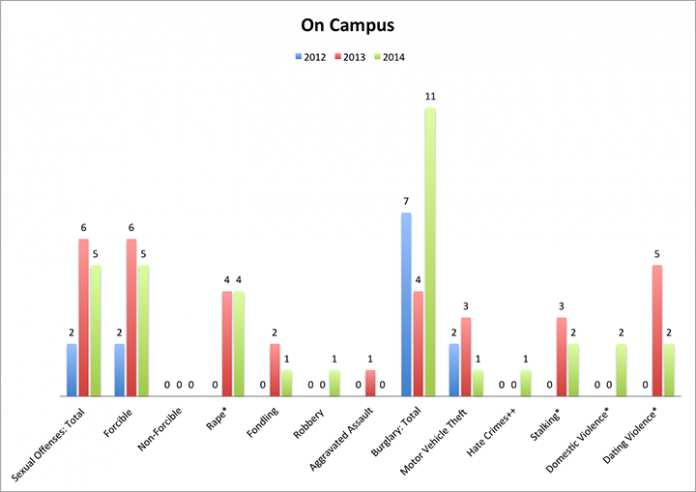By Emma King, Staff Writer
Baylor’s annual fire safety and security report for 2015 showed a 175 percent increase in burglaries and a 7.2 percent increase in liquor law violations from 2013 to 2014.
Baylor’s Police Chief Brad Wigtil said it’s difficult to tell why some of these numbers are increasing. It could be that more of these crimes are occurring, or it could be that more of them are actually being caught by the community and reported to authorities.
“Sometimes we really don’t know the genesis of an increase or a decrease,” Wigtil said.
Wigtil said the increase in burglaries in particular caught his eye. There were 11 on campus in 2014, eight of which were not by forced entry.
“I think that people are leaving their offices open or, let’s say, their dorm rooms open. It’s creating that opportunity,” Wigtil said.
The Baylor Department of Public Safety’s online campus fire and crime log lists a number of recent burglaries from September and October where there was property stolen from dorm rooms, with no sign of forced entry, or where unlocked bikes were taken.
Wigtil said the safety and security report lets Baylor’s community know what has been happening, so they can decrease the opportunities for crimes to take place in the future.
“That information in there empowers them to make informed decisions concerning their personal safety,” Wigtil said.
For example, the report states that in 2014 there were five sexual offenses (four of which were rapes), one hate crime, one motor vehicle theft, two stalking cases, two domestic violence cases, two dating violence cases, 74 liquor law violations and 11 drug violations, all on campus. In 2013, there were six sexual offenses (including four rapes), three motor vehicle thefts, three stalking cases, five dating violence cases, 69 liquor law violations and 11 drug violations on campus.
The hate crime on Baylor’s campus was vandalism of a construction worker’s property on a Baylor building construction site.
Because the report is released as part of the Jeanne Clery Act, which requires all universities that receive federal funding to share information about crime and crime prevention on their campuses, Baylor’s report can be compared to data from similar schools.
The report from Southern Methodist University stated that they had only two burglaries in 2014, four forced sexual offenses, three forced sexual offenses not reported to the police (which Baylor’s report does not include), no hate crimes, four motor vehicle thefts, two stalking cases, no domestic violence cases, two dating violence cases, 71 liquor law violations and 17 drug violations.
In addition to listing the crime statistics, the reports also list policies and contact information for reporting incidents or crimes.
“It’s important for the community to understand the Department of Public Safety’s mission and the services we provide,” Wigtil said.
The annual report is a helpful resource, said Lori Fogleman, Baylor’s assistant vice president for media communications.
She said it helps the university know where it needs to improve, but it also shows the students, faculty and families what Baylor is already doing.
“One crime of any kind is too many, and our goals are to eliminate the situations from happening, protect all individuals on our campus and provide caring assistance to victims of sexual assault or any other crimes that might occur on our campus,” Fogleman said.
She said one of the ways Baylor strives to meet those goals is by educating the campus community on crime prevention.
“I think that’s one of the most important things about this report,” Fogleman said.
She said that the campus administration realizes that the efforts to educate students may lead to more reported crimes and higher numbers on the reports.
“If you see something, say something,” Wigtil said.
Wigtil said that the Department of Public Safety needs help from the Baylor community to improve overall safety on campus.
He said that he hopes the report will help motivate a partnership between the police and the general population.
“We just want you to call us, as part of a team, as part of a community effort,” Wigtil said.






